The Evaluation of ERA5’s Applicability in Nearshore Western Atlantic Regions During Hurricanes—“ISAIAS” 2020
Abstract
1. Introduction
2. Materials and Methods
2.1. Study Area
2.2. Data
2.2.1. Buoy Data
2.2.2. ERA5 Data
2.3. Methodology
3. Results
3.1. Accuracy Assessment of WS During “ISAIAS”
3.1.1. Spatial Distribution of WS
3.1.2. WS Error Analysis
3.2. Accuracy Assessment of SST During “ISAIAS”
3.2.1. Spatial Distribution of SST
3.2.2. SST Error Analysis
3.3. Accuracy Assessment of SSP During “ISAIAS”
3.3.1. Spatial Distribution of SSP
3.3.2. SSP Error Analysis
4. Discussion
5. Conclusions
Author Contributions
Funding
Institutional Review Board Statement
Informed Consent Statement
Data Availability Statement
Conflicts of Interest
Abbreviations
| WS | wind speed |
| SST | sea-surface temperature |
| SSP | sea-surface pressure |
| NDBC | National data Buoy Center |
| ECMWF | European Centre for Medium-Range Weather Forecasts |
| NHC | National Hurricane Center |
| Lat | Latitude |
| Lon | Longitude |
| CC | correlation coefficient |
| RMSE | root mean square error |
| MD | mean deviation |
References
- Xue, Y.; Simon, S.M.; Anderson, J.R.; Pegion, P.; Barton, N.P.; Baggett, C.F.; Stan, C.; Johnson, N.C.; Akella, S.; Becker, E.; et al. Advancing NOAA’s Subseasonal and Seasonal Applications and Enhancing Collaboration among Stakeholders, Modelers, and Researchers. Bull. Am. Meteorol. Soc. 2025, 106, E1295–E1302. [Google Scholar] [CrossRef]
- Sheng, C.; Bocchini, P. An Improved Physics-Based Hurricane Track Model over the North Atlantic Basin with Its Application for Wind-Hazard Assessment. J. Struct. Eng. 2025, 151, 04025122. [Google Scholar] [CrossRef]
- Cannon, J.B.; Whelan, A.W.; Johnson, A.S.; Wells, M.L. Mitigating tropical cyclone susceptibility in pecan (Carya illinoinensis) orchards. Sci. Hortic. 2025, 349, 114236. [Google Scholar] [CrossRef]
- Bethel, B.J.; Dong, C.; Wang, J.; Cao, Y. An analysis of surface waves in the Caribbean Sea based on a high-resolution numerical wave model. Ocean Model. 2024, 190, 102377. [Google Scholar] [CrossRef]
- Martinez, B.; Da Silva, B.F.; Aristizabal-Henao, J.J.; Denslow, N.D.; Osborne, T.Z.; Morrison, E.S.; Bianchi, T.S.; Bowden, J.A. Increased levels of perfluorooctanesulfonic acid (PFOS) during Hurricane Dorian on the east coast of Florida. Environ. Res. 2022, 208, 112635. [Google Scholar] [CrossRef] [PubMed]
- Cantine, M.; Orzechowski, E.; Stein, N.; Lincoln, T.; Hibner, B.; Present, T.; Thorpe, M.; Strauss, J.; Rumbelsperger, A.M.B.; Knoll, A.H.; et al. Rapid growth of a carbonate island over the last millennium. Sedimentology 2024, 71, 2119–2143. [Google Scholar] [CrossRef]
- Grey, S.; Liu, Y.; Simmons, J. Hurricane surge and inundation in the Bahamas, part 2: Flood risk assessment. J. Flood Risk Manag. 2025, 18, e13022. [Google Scholar] [CrossRef]
- Miyamoto, Y.; Yamaura, T.; Yoshida, R.; Yashiro, H.; Tomita, H.; Kajikawa, Y. Precursors of deep moist convection in a subkilometer global simulation. J. Geophys. Res. Atmos. 2016, 121, 12080–12088. [Google Scholar] [CrossRef]
- Jiang, D.; Huang, B.; Miao, Q.; Sun, H.; Wang, Z. Typhoon wind and wave numerical forecasting optimization in the South China Sea based on observation data. Nat. Hazards 2025, 121, 9653–9677. [Google Scholar] [CrossRef]
- Shanahan, T.; Fitzgerald, B. Wind–Wave Misalignment in Irish Waters and Its Impact on Floating Offshore Wind Turbines. Energies 2025, 18, 372. [Google Scholar] [CrossRef]
- Sreejith, M.; Remya, P.G.; Sreelakshmi, S.; Kumar, B.P.; Malavika, S.; Nair, T.M.B.; Kumar, T.S. A Performance Evaluation of CMIP6 Wind Fields for Robust Forcing in Indian Ocean Wave Climate Studies. Int. J. Clim. 2025, 45, e8744. [Google Scholar] [CrossRef]
- Dai, Y.; Abhishek, L.; Gong, Y.; Wu, X.; Sheng, B.; Zhao, W. Variations in Present and Future Hourly Extreme Rainfall: Insights from High-Resolution Data and Novel Temporal Disaggregation Model. Water 2024, 16, 3463. [Google Scholar] [CrossRef]
- Atkinson, J.; Smith, J.M.; Bender, C. Sea-Level Rise Effects on Storm Surge and Nearshore Waves on the Texas Coast: Influence of Landscape and Storm Characteristics. J. Waterw. Port Coast. Ocean Eng. 2013, 139, 98–117. [Google Scholar] [CrossRef]
- Sakazaki, T.; Fujiwara, M.; Zhang, X.; Hagan, M.E.; Forbes, J.M. Diurnal tides from the troposphere to the lower mesosphere as deduced from TIMED/SABER satellite data and six global reanalysis data sets. J. Geophys. Res. Atmos. 2012, 117. [Google Scholar] [CrossRef]
- Babagolimatikolaei, J. A comparative study of the sensitivity of an ocean model outputs to atmospheric forcing: ERA-Interim vs. ERA5 for Adriatic Sea Ocean modelling. Dyn. Atmos. Ocean. 2025, 109, 101525. [Google Scholar] [CrossRef]
- Ding, M.; Zhang, L.; Dou, T.; Huang, Y.; Luo, Y.; Lyu, J.; Xiao, C. On the Shallowing of Antarctic Low-Level Temperature Inversions Projected by CESM-LE under RCP8.5. J. Meteorol. Res. 2024, 38, 586–599. [Google Scholar] [CrossRef]
- King, J.C.; Marshall, G.J.; Colwell, S.; Arndt, S.; Allen-Sader, C.; Phillips, T. The performance of the ERA-Interim and ERA5 atmospheric reanalyses over Weddell Sea pack ice. J. Geophys. Res. Ocean. 2022, 127, e2022JC018805. [Google Scholar] [CrossRef]
- Munsi, A.; Kesarkar, A.; Bhate, J.; Panchal, A.; Singh, K.; Kutty, G.; Giri, R. Rapidly intensified, long duration North Indian Ocean tropical cyclones: Mesoscale downscaling and validation. Atmos. Res. 2021, 259, 105678. [Google Scholar] [CrossRef]
- Sahu, H.; Burman, P.K.D.; Gnanamoorthy, P.; Song, Q.; Zhang, Y.; Wang, H.; Chen, Y.; Wang, S. Estimating latent heat flux of subtropical forests using machine learning algorithms. Meteorol. Appl. 2025, 32, e70023. [Google Scholar] [CrossRef]
- Mooney, P.A.; Mulligan, F.J.; Fealy, R. Comparison of ERA-40, ERA-Interim and NCEP/NCAR reanalysis data with observed surface air temperatures over Ireland. Int. J. Climatol. 2011, 31, 545–557. [Google Scholar] [CrossRef]
- Decker, M.; Brunke, M.A.; Wang, Z.; Sakaguchi, K.; Zeng, X.; Bosilovich, M.G. Evaluation of the reanalysis products from GSFC, NCEP, and ECMWF using flux tower observations. J. Clim. 2012, 25, 1916–1944. [Google Scholar] [CrossRef]
- Wang, C.; Graham, R.M.; Wang, K.; Gerland, S.; Granskog, M.A. Comparison of ERA5 and ERA-Interim near-surface air temperature, snowfall and precipitation over Arctic sea ice: Effects on sea ice thermodynamics and evolution. Cryosphere 2019, 13, 1661–1679. [Google Scholar] [CrossRef]
- Tarek, M.; Brissette, F.P.; Arsenault, R. Evaluation of the ERA5 reanalysis as a potential reference dataset for hydrological modelling over North America. Hydrol. Earth Syst. Sci. 2020, 24, 2527–2544. [Google Scholar] [CrossRef]
- Lv, X.; Yuan, D.; Ma, X.; Tao, J. Wave characteristics analysis in Bohai Sea based on ECMWF wind field. Ocean Eng. 2014, 91, 159–171. [Google Scholar] [CrossRef]
- Mondal, I.; Das, A.; Hossain, S.A.; Jose, F.; Altuwaijri, H.A. Climate change-induced vulnerability assessment for the Florida Coast using hybrid machine learning models. Ecol. Indic. 2025, 171, 113242. [Google Scholar] [CrossRef]
- Wang, K.; Chen, J.; Valseth, E.; Wells, G.; Bettadpur, S.; Jones, C.E.; Dawson, C. Subtle land subsidence elevates future storm surge risks along the Gulf Coast of the United States. J. Geophys. Res. Earth Surf. 2024, 129, e2024JF007858. [Google Scholar] [CrossRef]
- Klotzbach, P.J.; Wood, K.M.; Bell, M.M.; Blake, E.S.; Bowen, S.G.; Caron, L.P.; Collins, J.M.; Gibney, E.J.; Schreck, C.J., III; Truchelut, R.E. A hyperactive end to the Atlantic hurricane season October–November 2020. Bull. Am. Meteorol. Soc. 2022, 103, E110–E128. [Google Scholar] [CrossRef]
- Shi, J.; Hu, C.; Cannizzaro, J.; Barnes, B.; Zhang, Y.; Lembke, C.; Le Henaff, M. Intensification of Hurricane Idalia by a river plume in the eastern Gulf of Mexico. Environ. Res. Lett. 2025, 20, 024050. [Google Scholar] [CrossRef]
- Mao, S.; Shropshire, T.; He, R. Quantifying surface shelf water export in the southern middle Atlantic Bight using a Lagrangian particle tracking approach. J. Geophys. Res. Ocean. 2024, 129, e2023JC020752. [Google Scholar] [CrossRef]
- Monica, S.B.; Wallace, D.J.; Wallace, E.J.; Du, X.; Dee, S.G.; Anderson, J.B. 4500-year paleohurricane record from the Western Gulf of Mexico, Coastal Central TX, USA. Mar. Geol. 2024, 473, 107303. [Google Scholar] [CrossRef]
- Lodise, J.; Merrifield, S.; Collins, C.; Rogowski, P.; Behrens, J.; Terrill, E. Global climatology of extratropical cyclones from a new tracking approach and associated wave heights from satellite radar altimeter. J. Geophys. Res. Ocean. 2022, 127, e2022JC018925. [Google Scholar] [CrossRef]
- Manchia, C.M.; Mulligan, R.P. Hurricane wind-driven surface waves on a narrow continental shelf and exposed coast. Cont. Shelf Res. 2022, 237, 104681. [Google Scholar] [CrossRef]
- Ayyad, M.; Orton, P.M.; El Safty, H.; Chen, Z.; Hajj, M.R. Ensemble forecast for storm tide and resurgence from Tropical Cyclone Isaias. Weather. Clim. Extrem. 2022, 38, 100504. [Google Scholar] [CrossRef]
- Bu, J.; Wang, Q.; Ni, J. Estimating sea surface swell height using a hybrid model combining CNN, ConvLSTM, and FCN based on spaceborne GNSS-R data from the CYGNSS mission. GPS Solut. 2024, 28, 133. [Google Scholar] [CrossRef]
- Wang, X.; Jiang, L.; Guo, Z.; Xie, X.; Li, L.; Gong, K.; Hu, J. Influence of meteorological reanalysis field on air quality modeling in the Yangtze River Delta, China. Atmos. Environ. 2024, 318, 120231. [Google Scholar] [CrossRef]
- Vance, J.M.; Currie, K.; Zeldis, J.; Dillingham, P.W.; Law, C.S. An empirical MLR for estimating surface layer DIC and a comparative assessment to other gap-filling techniques for ocean carbon time series. Biogeosciences 2022, 19, 241–269. [Google Scholar] [CrossRef]
- Nadezhda, V.; Anna, R.; Egor, D. High-resolution bias-corrected precipitation data over South Siberia, Russia. Atmos. Res. 2021, 254, 105528. [Google Scholar]
- Xiong, Y.; Zhao, T.; Lü, H.; Peng, Z.; Zheng, J.; Bai, Y.; Yao, P.; Guo, P.; Song, P.; Wei, Z.; et al. FengYun-3 meteorological satellites’ microwave radiation Imagers enhance land surface temperature measurements across the diurnal cycle. ISPRS J. Photogramm. Remote. Sens. 2025, 222, 204–224. [Google Scholar] [CrossRef]
- Xue, Y.; Li, J.; Menzel, W.P.; Borbas, E.; Ho, S.; Li, Z.; Li, J. Characteristics of satellite sampling errors in total precipitable water from SSMIS, HIRS, and COSMIC observations. J. Geophys. Res. Atmos. 2019, 124, 6966–6981. [Google Scholar] [CrossRef]
- Hillebrand, F.L.; Bremer, U.F.; Arigony-Neto, J.; da Rosa, C.N.; Mendes, C.W.; Costi, J.; de Freitas, M.W.D.; Schardong, F. Comparison between atmospheric reanalysis models ERA5 and ERA-Interim at the North Antarctic Peninsula region. Ann. Assoc. Am. Geogr. 2021, 111, 1147–1159. [Google Scholar] [CrossRef]
- Zhang, X.; Xie, J.; Yao, G.; Cao, C. Extraction of Significant Wave Height from Spreading First-Order Bragg Peaks of Shipborne High-Frequency Surface Wave Radar with a Single Antenna. Remote. Sens. 2025, 17, 1006. [Google Scholar] [CrossRef]
- Dimitriadou, K.; Olsen, B.T.; Badger, M.; Hasager, C.B. SAR offshore wind fields in the Gulf of Lion. J. Appl. Meteorol. Climatol. 2025, 64, 353–364. [Google Scholar] [CrossRef]
- Chen, B.F.; Davis, C.A.; Kuo, Y.H. Examination of the combined effect of deep-layer vertical shear direction and lower-tropospheric mean flow on tropical cyclone intensity and size based on the ERA5 reanalysis. Mon. Weather Rev. 2021, 149, 4057–4076. [Google Scholar] [CrossRef]
- Duan, Y.; Liu, H.; Feng, M.; Song, X.; Li, K.; Liu, L.; Liu, B.; Yang, G.; Yu, W. The onset process of the 2018/2019 Indonesian–Australian summer monsoon: The importance of the air–sea interaction. Front. Mar. Sci. 2023, 9, 1089493. [Google Scholar] [CrossRef]
- Dymova, O.; Markova, N. Numerical Estimation of the Black Sea Circulation near the Continental Slope Using SKIRON and ERA5 Atmospheric Forcing. Environ. Sci. Proc. 2023, 25, 61. [Google Scholar]
- Ricker, M.; Kousal, J.; Günther, H.; Behrens, A.; Staneva, J. The Introduction of Observation-Based Wave Physics into the Wind-Wave Model WAM: Wave Assessments for a Semi-Enclosed Basin. Ocean Model. 2025, 197, 102564. [Google Scholar] [CrossRef]
- Gao, Y.; Guan, C.; Sun, J.; Xie, L. Tropical cyclone wind speed retrieval from dual-polarization Sentinel-1 EW mode products. J. Atmos. Ocean. Technol. 2020, 37, 1713–1724. [Google Scholar] [CrossRef]
- Pereira, A.G.; Melo, D.L.; Dantas, M.I.S.; Barros, L.O.; Pereira, Á.M.; Ferreira, N.S.; Morais, R.S.; Seluchi, M.E. Strengths and limitations of the Gálvez-Davison Index in forecasting tropical and subtropical convection over South America. Atmos. Res. 2025, 323, 108184. [Google Scholar] [CrossRef]
- Abdikerimova, G.; Khamitova, D.; Kassymova, A.; Bissengaliyeva, A.; Nurova, G.; Aitimov, M.; Shynbergenov, Y.A.; Yessenova, M.; Bekbayeva, R. Development of a Model for Soil Salinity Segmentation Based on Remote Sensing Data and Climate Parameters. Algorithms 2025, 18, 285. [Google Scholar] [CrossRef]
- Paul, S.; Alemohammad, H. Examining the performance of precipitation products in characterizing the Indian summer monsoon rainfall (ISMR) using triple collocation. J. Hydrol. 2025, 657, 133136. [Google Scholar] [CrossRef]
- Huang, W.; Wu, X.; Xia, H.; Zhu, X.; Gong, Y.; Sun, X. Reinforcement learning-based multi-model ensemble for ocean waves forecasting. Front. Mar. Sci. 2025, 12, 1534622. [Google Scholar] [CrossRef]
- Zhao, P.; He, Z. Evaluation of ERA5 reanalysis temperature data over the Qilian Mountains of China. J. Mt. Sci. 2024, 22, 198–209. [Google Scholar] [CrossRef]
- Chen, X.; Ni, Y.; Shen, Y.; Ying, Y.; Wang, J. The research on the applicability of different typhoon wind fields in the simulation of typhoon waves in China’s coastal waters. Front. Mar. Sci. 2024, 11, 1492521. [Google Scholar] [CrossRef]
- Ascenso, G.; Ficchì, A.; Giuliani, M.; Scoccimarro, E.; Castelletti, A. Downscaling, bias correction, and spatial adjustment of extreme tropical cyclone rainfall in ERA5 using deep learning. Weather. Clim. Extrem. 2024, 46, 100724. [Google Scholar] [CrossRef]
- Wang, X.; Xu, M.; Kang, S.; Li, X.; Han, H.; Li, X. Comprehensive applicability evaluation of four precipitation products at multiple spatiotemporal scales in Northwest China. J. Arid Land 2024, 16, 1232–1254. [Google Scholar] [CrossRef]
- Tian, W.; Wu, Y.L.; Lin, C.; Zhang, J.G.; Sian, K.T.C.L.K. Assessing the Applicability of Multi-Source Precipitation Products over the Chinese Mainland and Its Seven Regions. J. Trop. Meteorol. 2024, 30, 275–288. [Google Scholar] [CrossRef]
- Park, I.; Ho, C.H.; Kim, J.; Kim, J.H.; Jun, S.Y. Development of a monthly PM2.5 forecast model for Seoul, Korea, based on the dynamic climate forecast and a convolutional neural network algorithm. Atmos. Res. 2024, 309, 107576. [Google Scholar] [CrossRef]
- Wilczak, J.M.; Akish, E.; Capotondi, A.; Compo, G.P. Evaluation and Bias Correction of the ERA5 Reanalysis over the United States for Wind and Solar Energy Applications. Energies 2024, 17, 1667. [Google Scholar] [CrossRef]
- Zhu, J.; Dai, Q.; Xiao, Y.; Liu, C.; Zhang, J.; Zhuo, L.; Han, D. Microphysics-based rainfall energy estimation using remote sensing and reanalysis data. J. Hydrol. 2023, 627, 130314. [Google Scholar] [CrossRef]
- Dhmane, L.A.; Moustadraf, J.; Rachdane, M.; Saidi, M.E.; Benjmel, K.; Amraoui, F.; Ezzaouini, M.A.; Sliman, A.A.; Hadri, A. Spatiotemporal Assessment and Correction of Gridded Precipitation Products in North Western Morocco. Atmosphere 2023, 14, 1239. [Google Scholar] [CrossRef]
- Kreuwel, F.P.; Knap, W.; Schmeits, M.; de Arellano, J.V.G.; van Heerwaarden, C.C. Forecasting day-ahead 1-minute irradiance variability from numerical weather predictions. Sol. Energy 2023, 258, 57–71. [Google Scholar] [CrossRef]
- Han, Z.; Yue, C.; Liu, C.; Gu, W.; Tang, Y.; Li, Y. Evaluation on the applicability of ERA5 reanalysis dataset to tropical cyclones affecting Shanghai. Front. Earth Sci. 2022, 16, 1025–1039. [Google Scholar] [CrossRef]
- Wang, R.; Zhou, R.; Yang, S.; Li, R.; Pu, J.; Liu, K.; Deng, Y. A New Algorithm for Estimating Low Cloud-Base Height in Southwest China. J. Appl. Meteorol. Climatol. 2022, 61, 1179–1197. [Google Scholar] [CrossRef]
- Liu, Y.; Zhuo, L.; Pregnolato, M.; Han, D. An assessment of statistical interpolation methods suited for gridded rainfall datasets. Int. J. Climatol. 2021, 42, 2754–2772. [Google Scholar] [CrossRef]
- Frid, S.E.; Lisitskaya, N.V.; Popel, O.S. Results of Analysis of the Applicability of Satellite Observations and Reanalysis Data for Simulations of Autonomous Solar Power Systems. Dokl. Phys. 2019, 64, 381–383. [Google Scholar] [CrossRef]
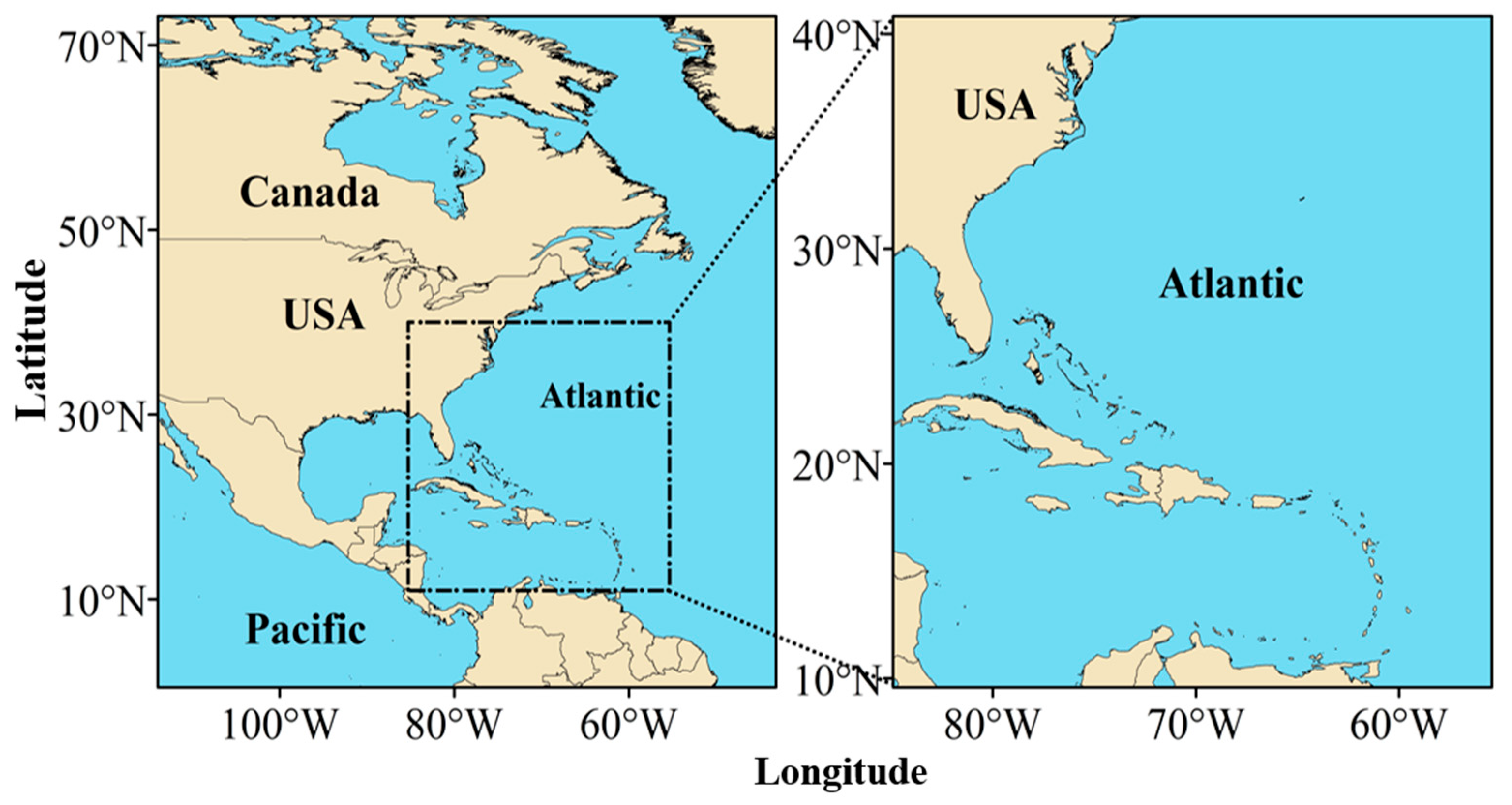


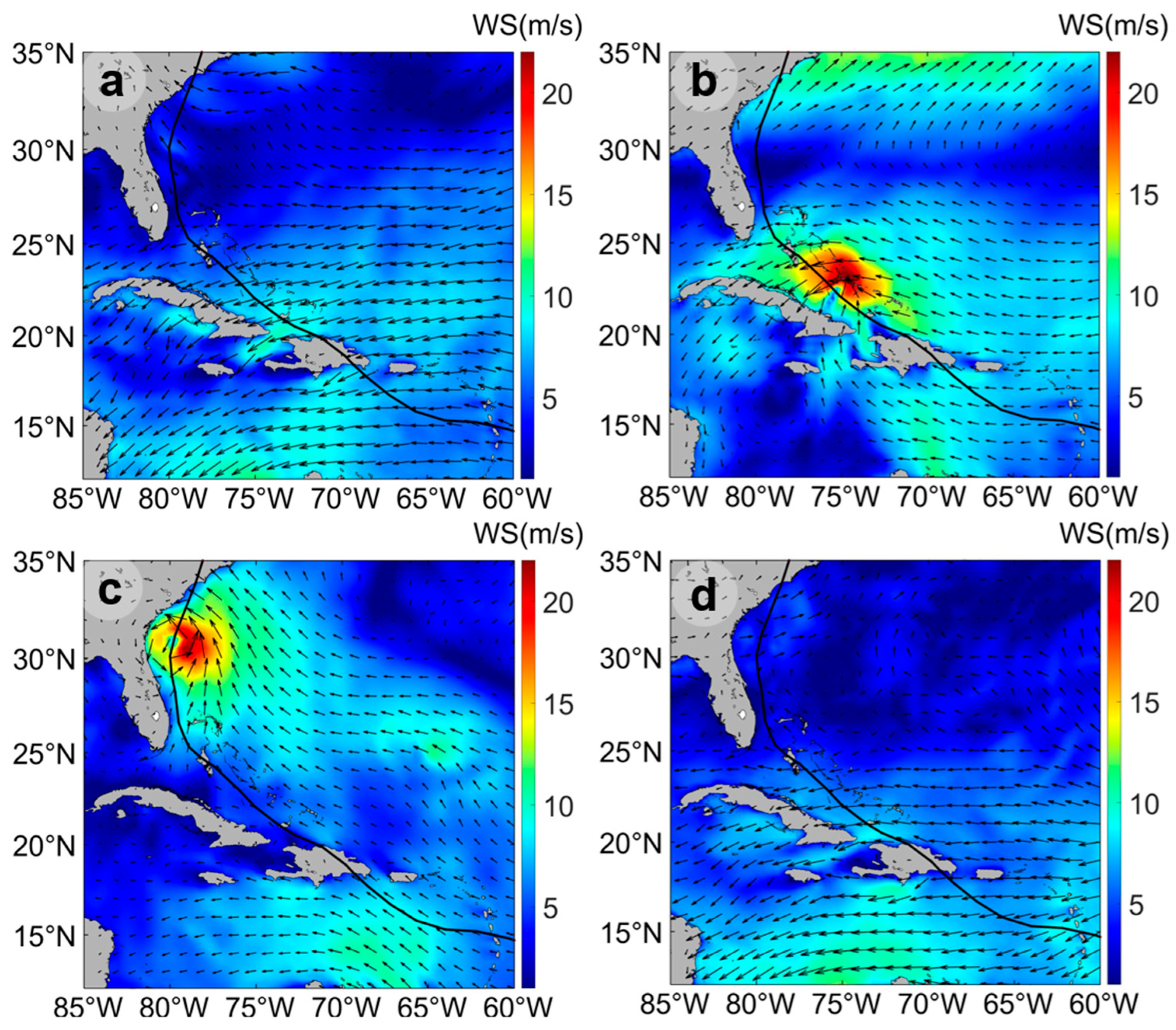
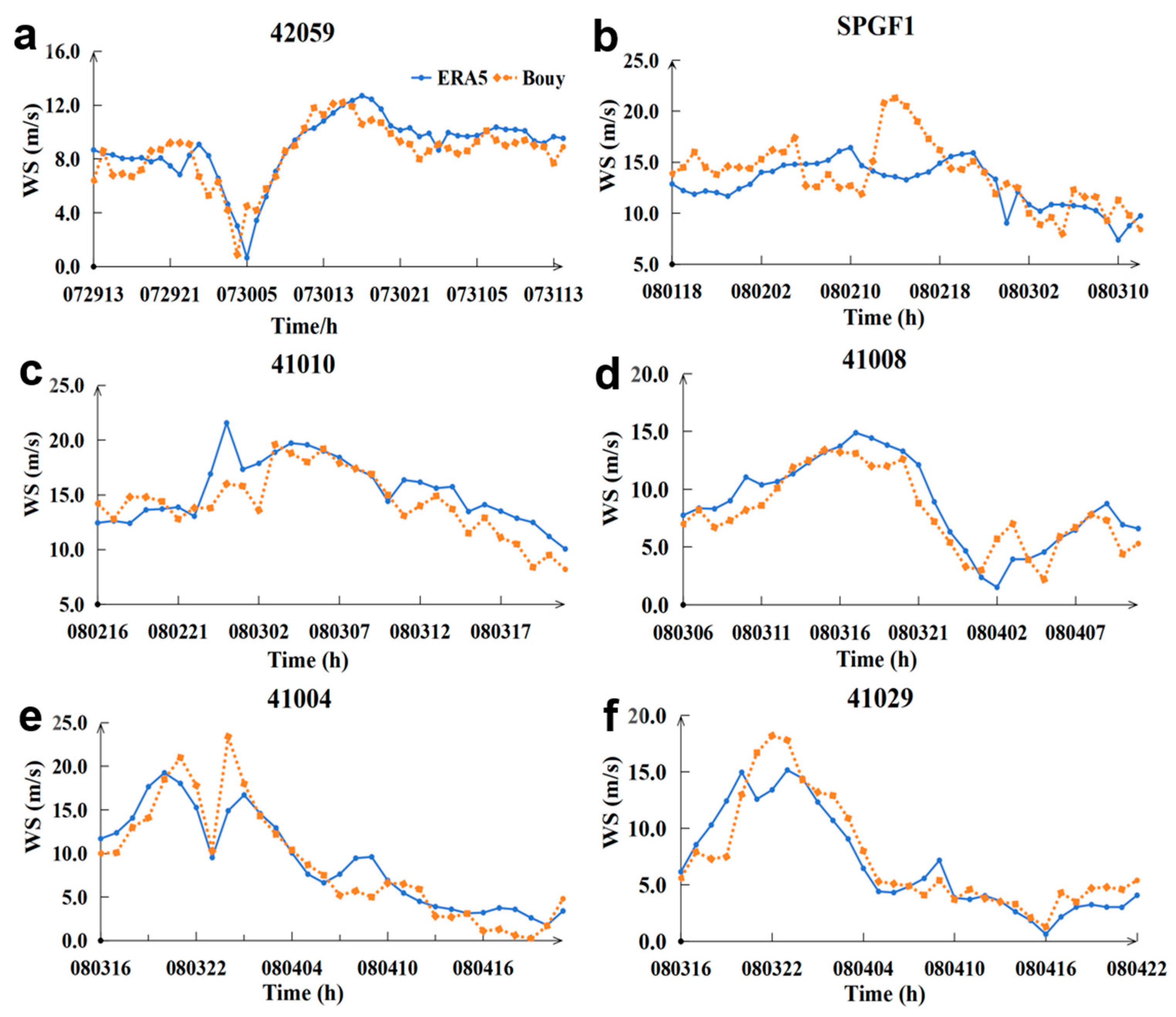
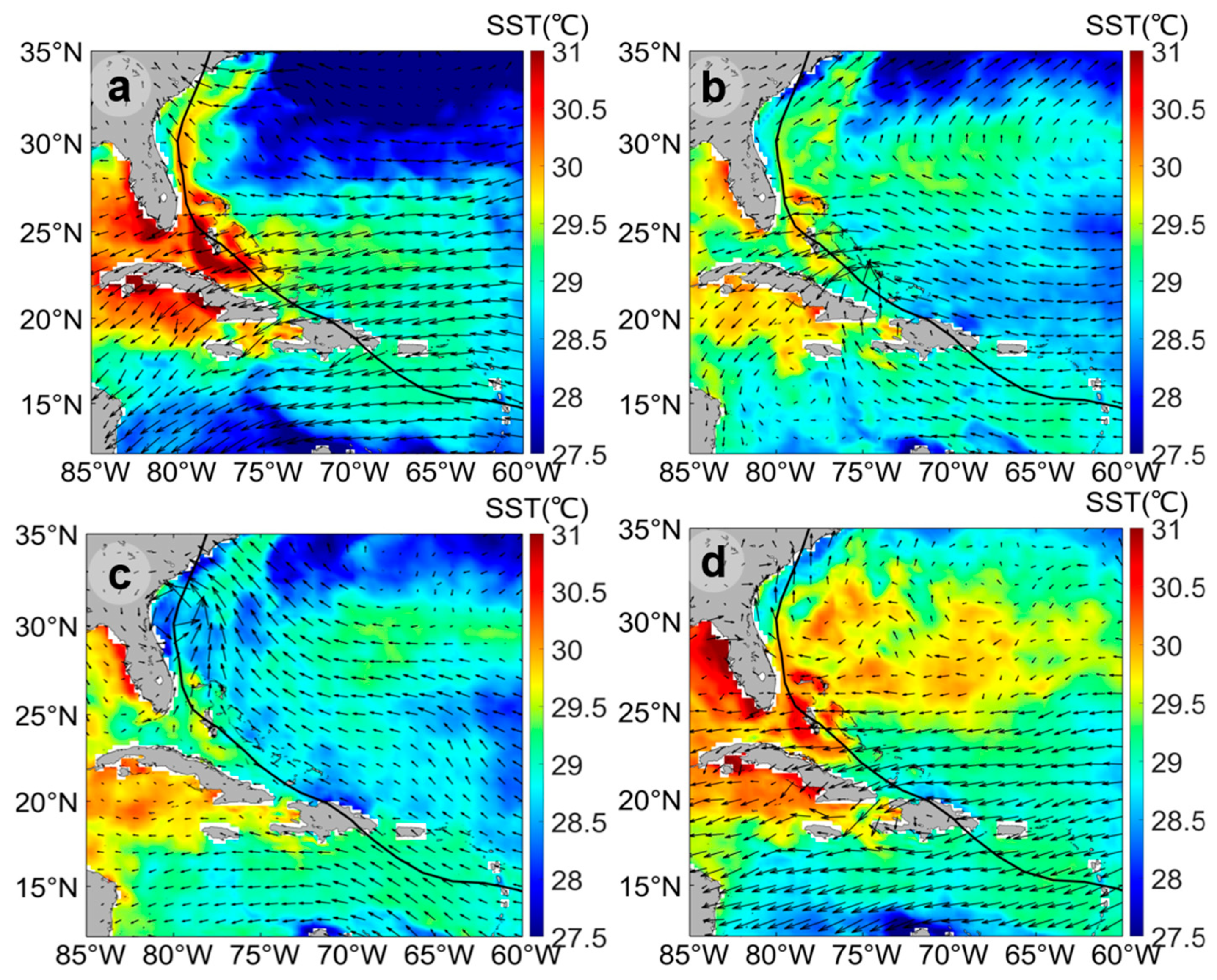
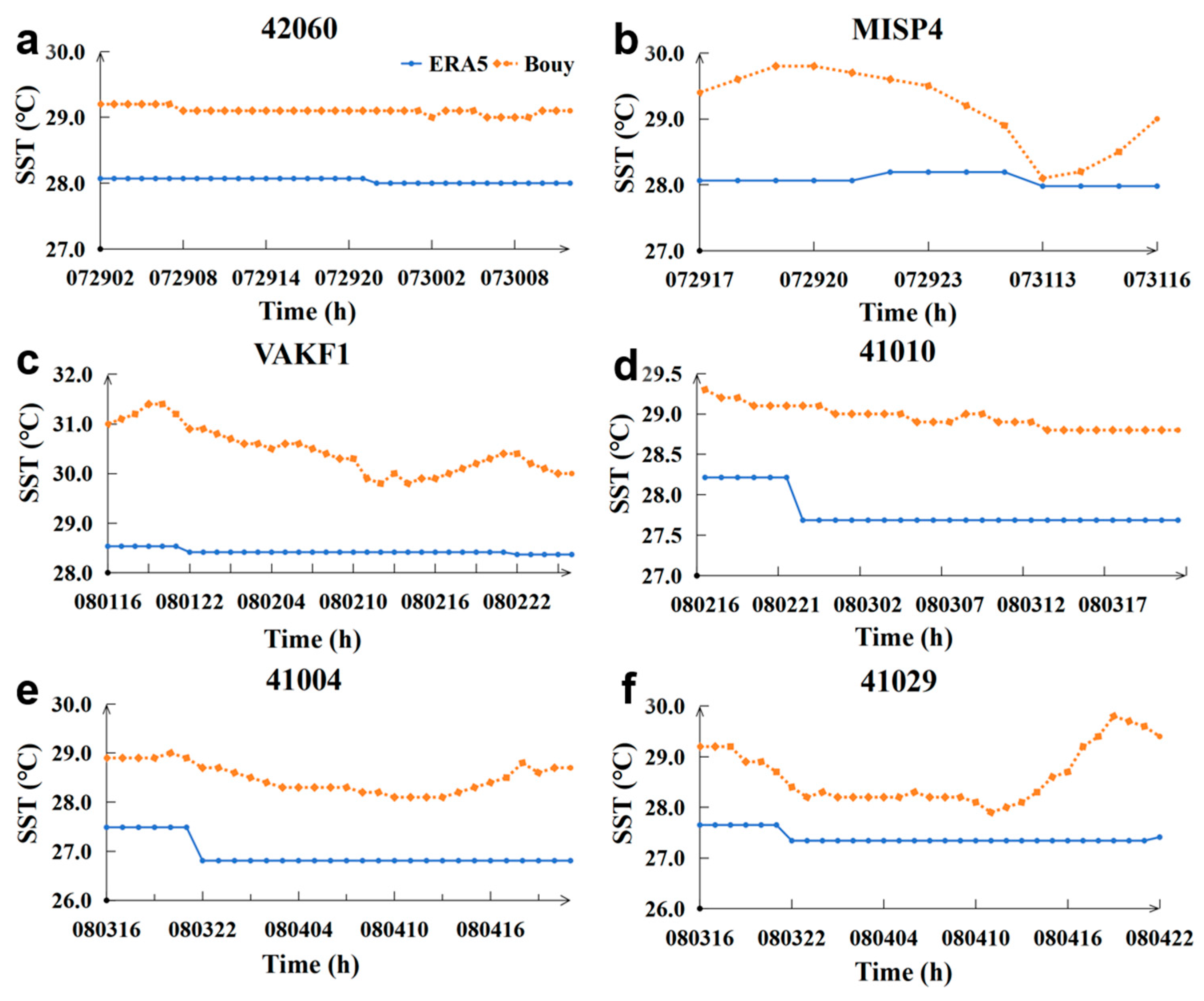

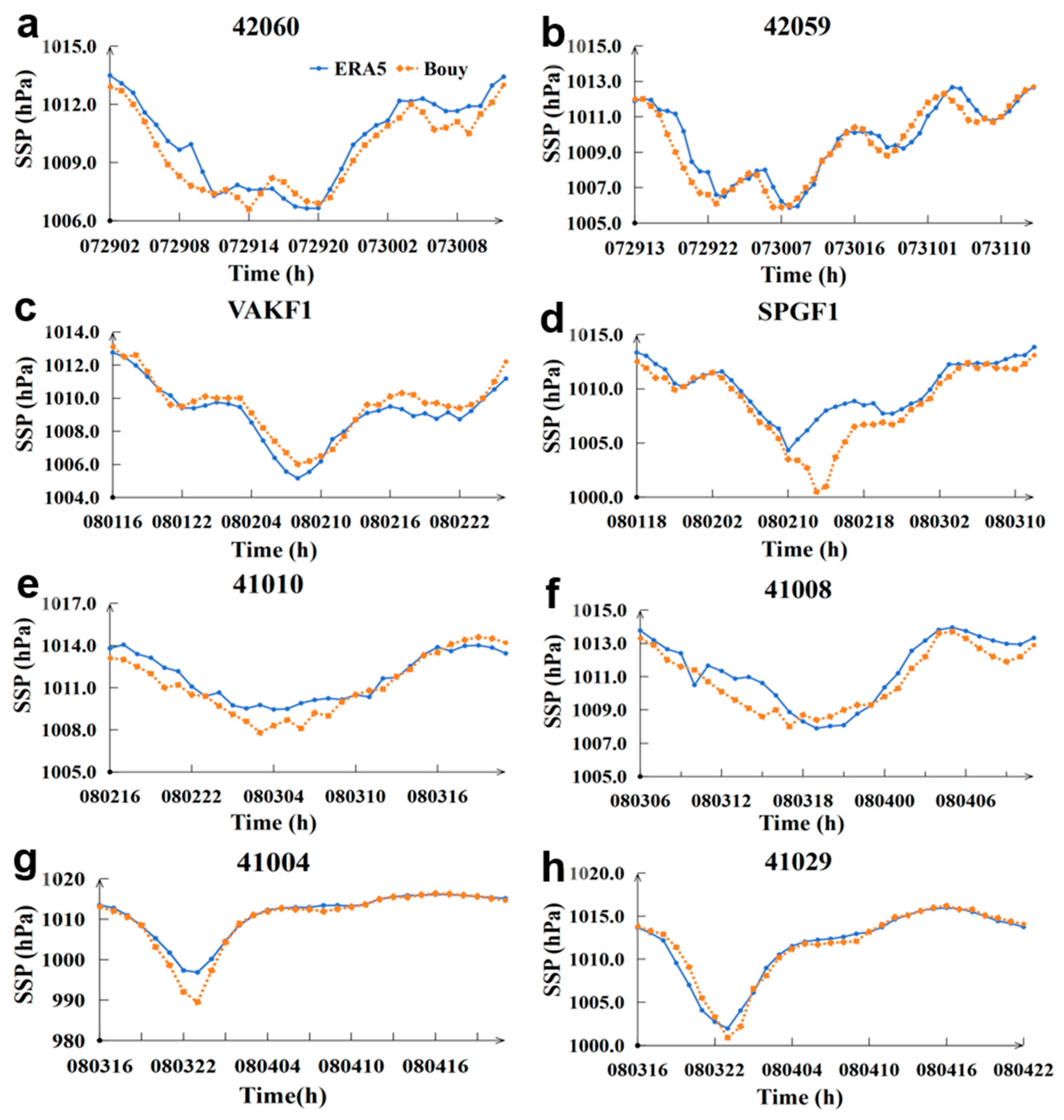
| Bouy | 41004 | 41008 | 41010 | 41029 | 42059 | 42060 | MISP4 | SPGF1 | VAKF1 |
|---|---|---|---|---|---|---|---|---|---|
| Lat (°N) | 32.502 | 31.400 | 28.878 | 32.803 | 15.300 | 16.434 | 18.090 | 26.704 | 25.731 |
| Lon (°W) | 79.099 | 80.866 | 78.467 | 79.624 | 67.483 | 63.329 | 67.939 | 78.995 | 80.162 |
| Data | Style | Source | Spatial Resolution | Time | Temporal Resolution |
|---|---|---|---|---|---|
| SST WS SSP | Bouy | NOBC | / | 29 July–5 August | 1 h |
| SST WS SST | ERA5 | ECMWF | 0.25 × 0.25° | 15 July–15 August | |
| Hurricane information | / | NHC | / |
| Station | CC | RMSE | MD |
|---|---|---|---|
| 42059 | 0.85 | 1.32 | 0.45 |
| SPGF1 | 0.52 | 2.92 | −0.99 |
| 41010 | 0.82 | 2.14 | 1.12 |
| 41008 | 0.90 | 1.74 | 0.75 |
| 41004 | 0.90 | 2.50 | −0.38 |
| 41029 | 0.94 | 1.96 | −0.51 |
| Station | CC | RMSE | MD |
|---|---|---|---|
| 42060 | 0.56 | 1.04 | −1.03 |
| MISP4 | 0.49 | 1.22 | −1.10 |
| VAKF1 | 0.76 | 2.07 | −2.03 |
| 41010 | 0.74 | 1.18 | −1.17 |
| 41004 | 0.73 | 1.57 | −1.55 |
| 41029 | 0.36 | 1.34 | −1.23 |
| Station | CC | RMSE | MD |
|---|---|---|---|
| 42060 | 0.96 | 0.81 | 0.52 |
| 42059 | 0.94 | 0.75 | 0.25 |
| VAKF1 | 0.97 | 0.62 | −0.45 |
| SPGF1 | 0.90 | 2.01 | 1.27 |
| 41010 | 0.95 | 0.88 | 0.51 |
| 41008 | 0.93 | 0.90 | 0.53 |
| 41004 | 0.99 | 0.92 | 0.89 |
| 41029 | 0.98 | 0.78 | −0.08 |
Disclaimer/Publisher’s Note: The statements, opinions and data contained in all publications are solely those of the individual author(s) and contributor(s) and not of MDPI and/or the editor(s). MDPI and/or the editor(s) disclaim responsibility for any injury to people or property resulting from any ideas, methods, instructions or products referred to in the content. |
© 2025 by the authors. Licensee MDPI, Basel, Switzerland. This article is an open access article distributed under the terms and conditions of the Creative Commons Attribution (CC BY) license (https://creativecommons.org/licenses/by/4.0/).
Share and Cite
Xu, Z.; Guo, B.; Song, G.; Mantravadi, V.S.; Xu, W.; Wan, C.; Sabuyi, J.S. The Evaluation of ERA5’s Applicability in Nearshore Western Atlantic Regions During Hurricanes—“ISAIAS” 2020. Atmosphere 2025, 16, 967. https://doi.org/10.3390/atmos16080967
Xu Z, Guo B, Song G, Mantravadi VS, Xu W, Wan C, Sabuyi JS. The Evaluation of ERA5’s Applicability in Nearshore Western Atlantic Regions During Hurricanes—“ISAIAS” 2020. Atmosphere. 2025; 16(8):967. https://doi.org/10.3390/atmos16080967
Chicago/Turabian StyleXu, Zhiyong, Biyun Guo, Guiting Song, Venkata Subrahmanyam Mantravadi, Wenjing Xu, Cheng Wan, and John Sikule Sabuyi. 2025. "The Evaluation of ERA5’s Applicability in Nearshore Western Atlantic Regions During Hurricanes—“ISAIAS” 2020" Atmosphere 16, no. 8: 967. https://doi.org/10.3390/atmos16080967
APA StyleXu, Z., Guo, B., Song, G., Mantravadi, V. S., Xu, W., Wan, C., & Sabuyi, J. S. (2025). The Evaluation of ERA5’s Applicability in Nearshore Western Atlantic Regions During Hurricanes—“ISAIAS” 2020. Atmosphere, 16(8), 967. https://doi.org/10.3390/atmos16080967







